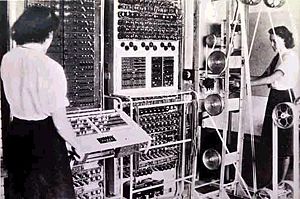Computing History Timeline
Heath Robinson
1943 the "Heath Robinson" development by Max Newman, Wynn Williams and their team
The Colossus machines were electronic computing devices used by British code breakers to read encrypted German messages during World War 2. These were the world’s first programmable (if not fully), digital, electronic, computing device.
Colossus was designed by engineer Tommy Flowers at the Post Office Research Station, Dollis Hill with input from mathematician Max Newman and group at Bletchley Park. The prototype, Colossus Mark I, was shown to be working in December 1943 and was operational at Bletchley Park by February 1944. An improved Colossus Mark II was first installed in June 1944, with input from Allen Coombs, and ten Colossi had been constructed by the end of the war.
The Colossus computers were used to help decipher teleprinter messages which had been encrypted using the Lorenz SZ40/42 machine. Colossus compared two data streams, counting each match based on a programmable Boolean function. The encrypted message was read at high speed from a paper tape. The other stream was generated internally, and was an electronic simulation of the Lorenz machine at various trial settings. If the match count for a setting was above a certain threshold, it would be output on an electric typewriter.

A Colossus Mark II computer. The slanted control panel on the left was used to set the pin patterns on the Lorenz; the paper tape transport is on the right.
The Colossus computers were used in the cryptanalysis of high-level German communications, messages which had been encrypted using the Lorenz SZ 40/42 cipher machine; part of the operation of Colossus was to emulate the mechanical Lorenz machine electronically.
Colossus was developed out of a prior project which produced a special purpose opto-mechanical comparator machine called "Heath Robinson". The main problem with Robinson was synchronising two paper tapes, one punched with the enciphered message, the other representing the patterns produced by the wheels of the Lorenz machine, that tended to stretch when being read at over 1000 characters per second, resulting in unreliable counts. Colossus solved this problem by reproducing one of the tapes electronically. The remaining single tape could be fed through Colossus at a higher speed and could be counted much more reliably.
By: Marija Pavlovska

